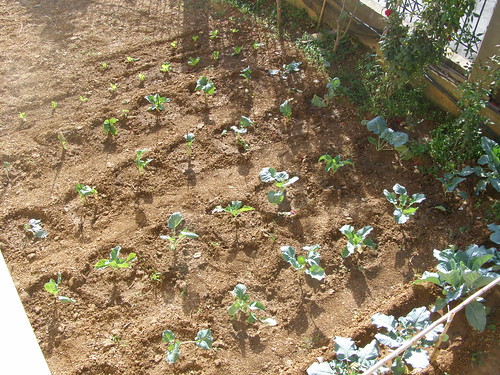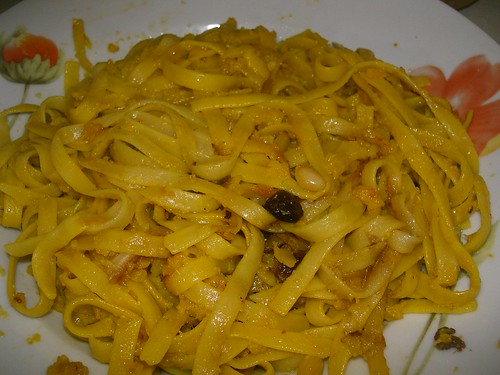I like to believe that the food I present in my blog is honest, simple, frugal, cheap, tasty, nutritious, sustainable and respectful, food that is within everyone's reach. The simplest meal combinations turn out to be the ones most well remembered by my eaters, who are my family, of course. I don't use any special techniques or ingredients and I try not to waste, especially anything we grow ourselves, to show respect not only to Mother Earth, but also to my husband who spends a good deal of his time in the garden, making it a fertile one all year round.
Here's a dish I recently prepared for our evening meal. Because of the curry flavour, the kids didn't try it, so maybe it's for more mature tastes; as Mediterraneans, they are not quite up to curry flavour. The addition of the chickpeas was last minute - but I thought they paired well with the cauliflower because both these ingredients are curry staples. The addition of a form of bean to a vegetable dish makes it a complete meal that includes protein, carbohydrates and roughage.
The quantities given for the ingredients are vague; it depends on how spicy you want your meal to be, and how many people are eating. You'll notice that i'm using ready-prepared ingredients, which have been prepped myself before I need them, eg boiled soaked chickpeas (so I must be preparing a chickpea stew for these to be hanging around) and finely chopped wild aromatic greens (so I must be preparing a spanakopita at some point soon), and
You need:
some par-boiled cauliflower florets: the amount of time you cook the cauliflower depends on your taste preferences (to be honest, I overcooked mine, which made it mushy)
1 small onion, sliced thinly
a few mixed greens, finely chopped (optional - it lends a nice flavour to the dish)
curry spices: I make my own with crushed garlic, cumin seed, chili pepper, turmeric and freshly grated ginger, something I learnt to do in New Zealand and have not changed my mix since that time
some soaked boiled chickpea
salt and pepper
some olive oil

Heat some olive oil in a low frying pan. Add the curry spices and cook till the garlic is translucent (about 1 minute). Then add the onion and allow it to wilt. Add the cauliflower and allow to heat through. Then add the mixed greens (if using) and chickpeas. Again, allow to heat through before seasoning.

Enjoy the dish with some crusty bread, some cheese and olives and a bit of wine. What could be simpler - as long as you have done your homework, that is!
©All Rights Reserved/Organically cooked. No part of this blog may be reproduced and/or copied by any means without prior consent from Maria Verivaki.
Here's a dish I recently prepared for our evening meal. Because of the curry flavour, the kids didn't try it, so maybe it's for more mature tastes; as Mediterraneans, they are not quite up to curry flavour. The addition of the chickpeas was last minute - but I thought they paired well with the cauliflower because both these ingredients are curry staples. The addition of a form of bean to a vegetable dish makes it a complete meal that includes protein, carbohydrates and roughage.
The quantities given for the ingredients are vague; it depends on how spicy you want your meal to be, and how many people are eating. You'll notice that i'm using ready-prepared ingredients, which have been prepped myself before I need them, eg boiled soaked chickpeas (so I must be preparing a chickpea stew for these to be hanging around) and finely chopped wild aromatic greens (so I must be preparing a spanakopita at some point soon), and
You need:
some par-boiled cauliflower florets: the amount of time you cook the cauliflower depends on your taste preferences (to be honest, I overcooked mine, which made it mushy)
1 small onion, sliced thinly
a few mixed greens, finely chopped (optional - it lends a nice flavour to the dish)
curry spices: I make my own with crushed garlic, cumin seed, chili pepper, turmeric and freshly grated ginger, something I learnt to do in New Zealand and have not changed my mix since that time
some soaked boiled chickpea
salt and pepper
some olive oil

Heat some olive oil in a low frying pan. Add the curry spices and cook till the garlic is translucent (about 1 minute). Then add the onion and allow it to wilt. Add the cauliflower and allow to heat through. Then add the mixed greens (if using) and chickpeas. Again, allow to heat through before seasoning.

Enjoy the dish with some crusty bread, some cheese and olives and a bit of wine. What could be simpler - as long as you have done your homework, that is!
©All Rights Reserved/Organically cooked. No part of this blog may be reproduced and/or copied by any means without prior consent from Maria Verivaki.

























